
Django的Form功能
- 生成HTML标签
- 验证用户数据(显示错误信息)
- HTML Form提交保留上次提交数据
- 初始化页面显示内容
Django form 流程
1、创建类,继承form.Form
2、页面根据类的对象自动创建html标签
3、提交,request.POST
封装到类的对象里,obj=UserInfo(request.POST)
4、用户输入是否合法
obj.is_valid()
5、全部合法,获取全部内容
obj.clean()
6、只有有不合法
obj.errors
1、创建Form类
from django.forms import Form
from django.forms import widgets
from django.forms import fields
class MyForm(Form):
user = fields.CharField(
widget=widgets.TextInput(attrs={'id': 'i1', 'class': 'c1'})
)
gender = fields.ChoiceField(
choices=((1, '男'), (2, '女'),),
initial=2,
widget=widgets.RadioSelect
)
city = fields.CharField(
initial=2,
widget=widgets.Select(choices=((1,'上海'),(2,'北京'),))
)
pwd = fields.CharField(
widget=widgets.PasswordInput(attrs={'class': 'c1'}, render_value=True)
)2、View函数处理
from django.shortcuts import render, redirect
from .forms import MyForm
def index(request):
if request.method == "GET":
obj = MyForm()
return render(request, 'index.html', {'form': obj})
elif request.method == "POST":
obj = MyForm(request.POST, request.FILES)
if obj.is_valid():
values = obj.clean()
print(values)
else:
errors = obj.errors
print(errors)
return render(request, 'index.html', {'form': obj})
else:
return redirect('http://www.google.com')3、生成HTML
<form action="/" method="POST" enctype="multipart/form-data">
<p>{{ form.user }} {{ form.user.errors }}</p>
<p>{{ form.gender }} {{ form.gender.errors }}</p>
<p>{{ form.city }} {{ form.city.errors }}</p>
<p>{{ form.pwd }} {{ form.pwd.errors }}</p>
<input type="submit"/>
</form>
<form method="POST" enctype="multipart/form-data">
{% csrf_token %}
{{ form.xxoo.label }}
{{ form.xxoo.id_for_label }}
{{ form.xxoo.label_tag }}
{{ form.xxoo.errors }}
<p>{{ form.user }} {{ form.user.errors }}</p>
<input type="submit" />
</form>Form类
创建Form类时,主要涉及到 【字段】 和 【插件】,字段用于对用户请求数据的验证,插件用于自动生成HTML;
1、Django内置字段如下:
Field
required=True, 是否允许为空
widget=None, HTML插件
label=None, 用于生成Label标签或显示内容
initial=None, 初始值
help_text='', 帮助信息(在标签旁边显示)
error_messages=None, 错误信息 {'required': '不能为空', 'invalid': '格式错误'}
show_hidden_initial=False, 是否在当前插件后面再加一个隐藏的且具有默认值的插件(可用于检验两次输入是否一直)
validators=[], 自定义验证规则
localize=False, 是否支持本地化
disabled=False, 是否可以编辑
label_suffix=None Label内容后缀
CharField(Field)
max_length=None, 最大长度
min_length=None, 最小长度
strip=True 是否移除用户输入空白
IntegerField(Field)
max_value=None, 最大值
min_value=None, 最小值
FloatField(IntegerField)
...
DecimalField(IntegerField)
max_value=None, 最大值
min_value=None, 最小值
max_digits=None, 总长度
decimal_places=None, 小数位长度
BaseTemporalField(Field)
input_formats=None 时间格式化
DateField(BaseTemporalField) 格式:2015-09-01
TimeField(BaseTemporalField) 格式:11:12
DateTimeField(BaseTemporalField)格式:2015-09-01 11:12
DurationField(Field) 时间间隔:%d %H:%M:%S.%f
...
RegexField(CharField)
regex, 自定制正则表达式
max_length=None, 最大长度
min_length=None, 最小长度
error_message=None, 忽略,错误信息使用 error_messages={'invalid': '...'}
EmailField(CharField)
...
FileField(Field)
allow_empty_file=False 是否允许空文件
ImageField(FileField) ...
注:需要PIL模块,pip3 install Pillow
以上两个字典使用时,需要注意两点:
- form表单中 enctype="multipart/form-data"
- view函数中 obj = MyForm(request.POST, request.FILES)
URLField(Field)
...
BooleanField(Field)
...
NullBooleanField(BooleanField)
...
ChoiceField(Field)
...
choices=(), 选项,如:choices = ((0,'上海'),(1,'北京'),)
required=True, 是否必填
widget=None, 插件,默认select插件
label=None, Label内容
initial=None, 初始值
help_text='', 帮助提示
ModelChoiceField(ChoiceField)
... django.forms.models.ModelChoiceField
queryset, # 查询数据库中的数据
empty_label="---------", # 默认空显示内容
to_field_name=None, # HTML中value的值对应的字段
limit_choices_to=None # ModelForm中对queryset二次筛选
ModelMultipleChoiceField(ModelChoiceField)
... django.forms.models.ModelMultipleChoiceField
TypedChoiceField(ChoiceField)
coerce = lambda val: val 对选中的值进行一次转换
empty_value= '' 空值的默认值
MultipleChoiceField(ChoiceField)
...
TypedMultipleChoiceField(MultipleChoiceField)
coerce = lambda val: val 对选中的每一个值进行一次转换
empty_value= '' 空值的默认值
ComboField(Field)
fields=() 使用多个验证,如下:即验证最大长度20,又验证邮箱格式
fields.ComboField(fields=[fields.CharField(max_length=20), fields.EmailField(),])
MultiValueField(Field)
PS: 抽象类,子类中可以实现聚合多个字典去匹配一个值,要配合MultiWidget使用
SplitDateTimeField(MultiValueField)
input_date_formats=None, 格式列表:['%Y--%m--%d', '%m%d/%Y', '%m/%d/%y']
input_time_formats=None 格式列表:['%H:%M:%S', '%H:%M:%S.%f', '%H:%M']
FilePathField(ChoiceField) 文件选项,目录下文件显示在页面中
path, 文件夹路径
match=None, 正则匹配
recursive=False, 递归下面的文件夹
allow_files=True, 允许文件
allow_folders=False, 允许文件夹
required=True,
widget=None,
label=None,
initial=None,
help_text=''
GenericIPAddressField
protocol='both', both,ipv4,ipv6支持的IP格式
unpack_ipv4=False 解析ipv4地址,如果是::ffff:192.0.2.1时候,可解析为192.0.2.1, PS:protocol必须为both才能启用
SlugField(CharField) 数字,字母,下划线,减号(连字符)
...
UUIDField(CharField) uuid类型
...注:UUID是根据MAC以及当前时间等创建的不重复的随机字符串
>>> import uuid
# make a UUID based on the host ID and current time
>>> uuid.uuid1() # doctest: +SKIP
UUID('a8098c1a-f86e-11da-bd1a-00112444be1e')
# make a UUID using an MD5 hash of a namespace UUID and a name
>>> uuid.uuid3(uuid.NAMESPACE_DNS, 'python.org')
UUID('6fa459ea-ee8a-3ca4-894e-db77e160355e')
# make a random UUID
>>> uuid.uuid4() # doctest: +SKIP
UUID('16fd2706-8baf-433b-82eb-8c7fada847da')
# make a UUID using a SHA-1 hash of a namespace UUID and a name
>>> uuid.uuid5(uuid.NAMESPACE_DNS, 'python.org')
UUID('886313e1-3b8a-5372-9b90-0c9aee199e5d')
# make a UUID from a string of hex digits (braces and hyphens ignored)
>>> x = uuid.UUID('{00010203-0405-0607-0809-0a0b0c0d0e0f}')
# convert a UUID to a string of hex digits in standard form
>>> str(x)
'00010203-0405-0607-0809-0a0b0c0d0e0f'
# get the raw 16 bytes of the UUID
>>> x.bytes
b'x00x01x02x03x04x05x06x07x08tnx0bx0crx0ex0f'
# make a UUID from a 16-byte string
>>> uuid.UUID(bytes=x.bytes)
UUID('00010203-0405-0607-0809-0a0b0c0d0e0f')2、Django内置插件:
TextInput(Input)
NumberInput(TextInput)
EmailInput(TextInput)
URLInput(TextInput)
PasswordInput(TextInput)
HiddenInput(TextInput)
Textarea(Widget)
DateInput(DateTimeBaseInput)
DateTimeInput(DateTimeBaseInput)
TimeInput(DateTimeBaseInput)
CheckboxInput
Select
NullBooleanSelect
SelectMultiple
RadioSelect
CheckboxSelectMultiple
FileInput
ClearableFileInput
MultipleHiddenInput
SplitDateTimeWidget
SplitHiddenDateTimeWidget
SelectDateWidget常用选择插件
# 单radio,值为字符串
# user = fields.CharField(
# initial=2,
# widget=widgets.RadioSelect(choices=((1,'上海'),(2,'北京'),))
# )
# 单radio,值为字符串
# user = fields.ChoiceField(
# choices=((1, '上海'), (2, '北京'),),
# initial=2,
# widget=widgets.RadioSelect
# )
# 单select,值为字符串
# user = fields.CharField(
# initial=2,
# widget=widgets.Select(choices=((1,'上海'),(2,'北京'),))
# )
# 单select,值为字符串
# user = fields.ChoiceField(
# choices=((1, '上海'), (2, '北京'),),
# initial=2,
# widget=widgets.Select
# )
# 多选select,值为列表
# user = fields.MultipleChoiceField(
# choices=((1,'上海'),(2,'北京'),),
# initial=[1,],
# widget=widgets.SelectMultiple
# )
# 单checkbox
# user = fields.CharField(
# widget=widgets.CheckboxInput()
# )
# 多选checkbox,值为列表
# user = fields.MultipleChoiceField(
# initial=[2, ],
# choices=((1, '上海'), (2, '北京'),),
# widget=widgets.CheckboxSelectMultiple
# )在使用选择标签时,需要注意choices的选项可以从数据库中获取,但是由于是静态字段 ***获取的值无法实时更新***,那么需要自定义构造方法从而达到此目的。
方式一:
from django.forms import Form
from django.forms import widgets
from django.forms import fields
from django.core.validators import RegexValidator
class MyForm(Form):
user = fields.ChoiceField(
# choices=((1, '上海'), (2, '北京'),),
initial=2,
widget=widgets.Select
)
def __init__(self, *args, **kwargs):
super(MyForm,self).__init__(*args, **kwargs)
# self.fields['user'].widget.choices = ((1, '上海'), (2, '北京'),)
# 或
self.fields['user'].widget.choices = models.Classes.objects.all().value_list('id','caption')方式二:
使用django提供的ModelChoiceField和ModelMultipleChoiceField字段来实现
from django import forms
from django.forms import fields
from django.forms import widgets
from django.forms import models as form_model
from django.core.exceptions import ValidationError
from django.core.validators import RegexValidator
class FInfo(forms.Form):
authors = form_model.ModelMultipleChoiceField(queryset=models.NNewType.objects.all())
# authors = form_model.ModelChoiceField(queryset=models.NNewType.objects.all())自定义验证规则
方式一:
from django.forms import Form
from django.forms import widgets
from django.forms import fields
from django.core.validators import RegexValidator
class MyForm(Form):
user = fields.CharField(
validators=[RegexValidator(r'^[0-9]+$', '请输入数字'), RegexValidator(r'^159[0-9]+$', '数字必须以159开头')],
)方式二:
import re
from django.forms import Form
from django.forms import widgets
from django.forms import fields
from django.core.exceptions import ValidationError
# 自定义验证规则
def mobile_validate(value):
mobile_re = re.compile(r'^(13[0-9]|15[012356789]|17[678]|18[0-9]|14[57])[0-9]{8}$')
if not mobile_re.match(value):
raise ValidationError('手机号码格式错误')
class PublishForm(Form):
title = fields.CharField(max_length=20,
min_length=5,
error_messages={'required': '标题不能为空',
'min_length': '标题最少为5个字符',
'max_length': '标题最多为20个字符'},
widget=widgets.TextInput(attrs={'class': "form-control",
'placeholder': '标题5-20个字符'}))
# 使用自定义验证规则
phone = fields.CharField(validators=[mobile_validate, ],
error_messages={'required': '手机不能为空'},
widget=widgets.TextInput(attrs={'class': "form-control",
'placeholder': u'手机号码'}))
email = fields.EmailField(required=False,
error_messages={'required': u'邮箱不能为空','invalid': u'邮箱格式错误'},
widget=widgets.TextInput(attrs={'class': "form-control", 'placeholder': u'邮箱'}))方法三:自定义方法
from django import forms
from django.forms import fields
from django.forms import widgets
from django.core.exceptions import ValidationError
from django.core.validators import RegexValidator
class FInfo(forms.Form):
username = fields.CharField(max_length=5,
validators=[RegexValidator(r'^[0-9]+$', 'Enter a valid extension.', 'invalid')], )
email = fields.EmailField()
def clean_username(self):
"""
Form中字段中定义的格式匹配完之后,执行此方法进行验证
:return:
"""
value = self.cleaned_data['username']
if "666" in value:
raise ValidationError('666已经被玩烂了...', 'invalid')
return value方式四:同时生成多个标签进行验证
from django.forms import Form
from django.forms import widgets
from django.forms import fields
from django.core.validators import RegexValidator
############## 自定义字段 ##############
class PhoneField(fields.MultiValueField):
def __init__(self, *args, **kwargs):
# Define one message for all fields.
error_messages = {
'incomplete': 'Enter a country calling code and a phone number.',
}
# Or define a different message for each field.
f = (
fields.CharField(
error_messages={'incomplete': 'Enter a country calling code.'},
validators=[
RegexValidator(r'^[0-9]+$', 'Enter a valid country calling code.'),
],
),
fields.CharField(
error_messages={'incomplete': 'Enter a phone number.'},
validators=[RegexValidator(r'^[0-9]+$', 'Enter a valid phone number.')],
),
fields.CharField(
validators=[RegexValidator(r'^[0-9]+$', 'Enter a valid extension.')],
required=False,
),
)
super(PhoneField, self).__init__(error_messages=error_messages, fields=f, require_all_fields=False, *args,
**kwargs)
def compress(self, data_list):
"""
当用户验证都通过后,该值返回给用户
:param data_list:
:return:
"""
return data_list
############## 自定义插件 ##############
class SplitPhoneWidget(widgets.MultiWidget):
def __init__(self):
ws = (
widgets.TextInput(),
widgets.TextInput(),
widgets.TextInput(),
)
super(SplitPhoneWidget, self).__init__(ws)
def decompress(self, value):
"""
处理初始值,当初始值initial不是列表时,调用该方法
:param value:
:return:
"""
if value:
return value.split(',')
return [None, None, None]初始化数据
在Web应用程序中开发编写功能时,时常用到获取数据库中的数据并将值初始化在HTML中的标签上。
1、Form
from django.forms import Form
from django.forms import widgets
from django.forms import fields
from django.core.validators import RegexValidator
class MyForm(Form):
user = fields.CharField()
city = fields.ChoiceField(
choices=((1, '上海'), (2, '北京'),),
widget=widgets.Select
)2、Views
from django.shortcuts import render, redirect
from .forms import MyForm
def index(request):
if request.method == "GET":
values = {'user': 'root', 'city': 2}
obj = MyForm(values)
return render(request, 'index.html', {'form': obj})
elif request.method == "POST":
return redirect('http://www.google.com')
else:
return redirect('http://www.google.com')3、HTML
<form method="POST" enctype="multipart/form-data">
{% csrf_token %}
<p>{{ form.user }} {{ form.user.errors }}</p>
<p>{{ form.city }} {{ form.city.errors }}</p>
<input type="submit"/>
</form>基于form的django图片上传
第一种,直接上传
views
class TestimgForm(forms.Form):
title = fields.CharField()
img = fields.FileField()
def testimg(request):
import os,time
if request.method == 'GET':
img = TestimgForm()
return render(request, 'backend/testimg.html',{'img':img})
else:
obj = TestimgForm(request.POST, request.FILES)
if obj.is_valid():
img = request.FILES.get('img')
time = time.strftime('%Y%m%d%H%M%S')
ext = os.path.splitext(img.name)[1]
file_path = os.path.join('upload/article',time+ext)
#将图片重命名
f = open(file_path,'wb')
for line in imgs.chunks():
f.write(line)
f.close()
return HttpResponse('上传成功')第二种,写入数据库
html
<!DOCTYPE html>
<html lang="en">
<head>
<title>Title</title>
</head>
<body>
<form action="testimg" method="post" enctype="multipart/form-data">
{% csrf_token %}
{{ img }}
<input type="submit" value="提交"/>
</form>
</body>
</html>views
class TestimgForm(forms.Form):
title = fields.CharField()
img = fields.FileField()
def testimg(request):
import os,time
if request.method == 'GET':
img = TestimgForm()
return render(request, 'backend/testimg.html',{'img':img})
else:
obj = TestimgForm(request.POST, request.FILES)
if obj.is_valid():
title = obj.cleaned_data['title']
img = obj.cleaned_data['img']
time = time.strftime('%Y%m%d%H%M%S')
ext = os.path.splitext(img.name)[1]
img.name = time + ext
Imgtest.objects.create(title=title,img=img)
return HttpResponse('上传成功')models.py
class Imgtest(models.Model):
title = models.CharField(verbose_name='标题',max_length=32,)
img = models.ImageField(verbose_name='缩略图',upload_to="./article/",
help_text="大小200*200,不超过200k",
default="/upload/article/common.jpg")完整代码
class TestimgForm(forms.Form):
title = fields.CharField()
img = fields.FileField()
def testimg(request):
import os,time
if request.method == 'GET':
img = TestimgForm()
return render(request, 'backend/testimg.html',{'img':img})
else:
obj = TestimgForm(request.POST, request.FILES)
if obj.is_valid():
#(request.FILES['file'])
# title = request.FILES.get('title')
# img = request.FILES.get('img')
title = obj.cleaned_data['title']
img = obj.cleaned_data['img']
time = time.strftime('%Y%m%d%H%M%S')
ext = os.path.splitext(img.name)[1]
img.name = time + ext
# Imgtest.objects.create(title=title,img=img)
# img是对象(文件大小,文件名称,文件内容。。。)
# file_path = os.path.join('upload/article',time+ext)
file_path = os.path.join('upload/article', img.name)
f = open(file_path,'wb')
for line in img.chunks():
f.write(line)
f.close()
return HttpResponse('...')Form定制化
定制错误信息
mail = forms.EmailField(error_messages={'required':u'邮箱不能为空'})
定制错误规则
mobile = forms.CharField(validators=[mobile_validate,],
error_messages={'required':u'手机不能为空'})
from django.shortcuts import render
from django import forms
import re
from django.core.exceptions import ValidationError
def mobile_validate(value):
mobile_re = re.compile(r'^(13[0-9]|15[012356789]|17[678]|18[0-9]|14[57])[0-9]{8}$')
if not mobile_re.match(value):
raise ValidationError('手机号码格式错误')
class UserInfo(forms.Form):
email = forms.EmailField(error_messages={'required':u'邮箱不能为空'})
host = forms.CharField(error_messages={'required':u'主机不能为空'})
port = forms.CharField(error_messages={'required':u'端口不能为空'})
mobile = forms.CharField(validators=[mobile_validate,], #定义错误规则函数
error_messages={'required':u'手机不能为空'},
widget=forms.TextInput(attrs={'class':'form-control', #定义class
'placeholder':u'请输入手机号'}))
beizhu = forms.CharField(required=False, #备注允许为空
widget=forms.Textarea(attrs={'class':'form-control', #定义为多行输入框
'placeholder':u'请输入备注'}))
user_type_choice = (
(0,u'普通用户'),
(1,u'高级用户'),
)
user_type = forms.IntegerField(widget=forms.widgets.Select(choices=user_type_choice,attrs={'class':'form-control'}))保存用户输入内容
obj = AccountForm.LoginForm(request.POST)Form表单验证以及错误信息
错误信息格式:
普通格式:
from django.shortcuts import render,HttpResponse
from web.forms import account as AccountForm
def login(request):
obj = AccountForm.LoginForm(request.POST)
if request.method == 'POST':
if obj.is_valid():
all_data = obj.clean()
else:
#用于Form表单提交
error = obj.errors
#print error['username'][0]
#print error['password'][0]
return render(request, 'account/login.html',{'obj':obj,'error':error})
return render(request, 'account/login.html',{'obj':obj})创建一个simple_tag,使其输 error['username'][0]
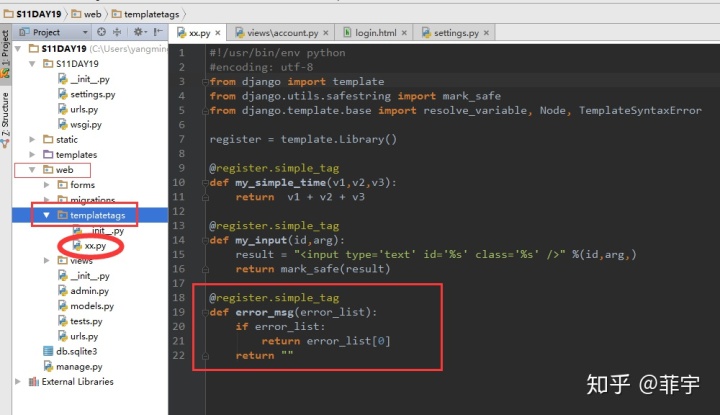
{% load xx %}
<!DOCTYPE html>
<html lang="en">
<head>
<meta charset="UTF-8">
<title></title>
</head>
<body>
<form action="/login/" method="post">
<p>{{ obj.username }}
{% error_msg error.username %}
</p>
<p>{{ obj.password }}
{% error_msg error.password %}
</p>
<input type="submit" value="提交">
</form>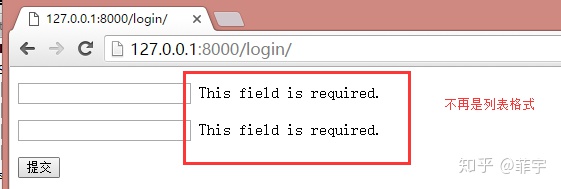
JSON格式
def login(request):
obj = AccountForm.LoginForm(request.POST)
if request.method == 'POST':
if obj.is_valid():
all_data = obj.clean()
else:
#用于Ajax
error = obj.errors.as_json()
#print error
return HttpResponse(error)
return render(request, 'account/login.html',{'obj':obj,'error':error})
return render(request, 'account/login.html',{'obj':obj})Form生成select标签



静态select
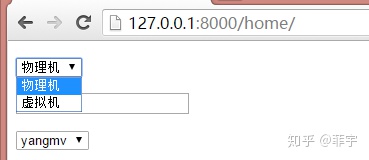
动态select
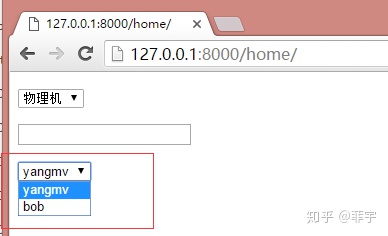
当增加数据库数据时


不会更新,除非关闭程序,重新载入才会更新


解决方法:利用面向对象类的静态字段
from django import forms
import json
class ImportForm(forms.Form):
#静态select
HOST_TYPE_LIST = (
(0,'物理机'),
(1,'虚拟机'),
)
host_type = forms.IntegerField(
widget=forms.Select(choices=HOST_TYPE_LIST)
)
hostname = forms.CharField()
#动态select
# admin_dic = ((1,'yangmv'),(1,"bob"),)
# w_obj = open('db_admin','w')
# w_obj.write(json.dumps(admin_dic))
# w_obj.close()
f_obj = open('db_admin','r')
data = f_obj.read()
data_tuple = json.loads(data)
admin = forms.IntegerField(
widget=forms.Select(choices=data_tuple)
)
def __init__(self,*args,**kwargs):
super(ImportForm,self).__init__(*args,**kwargs)
tmp = open('db_admin')
data = tmp.read()
data_tuple = json.loads(data)
self.fields['admin'].widget.choices = data_tuple再次增加数据库数据,直接刷新页面即可读取到新数据

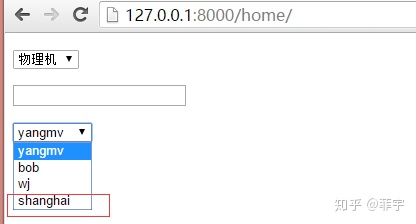
优化后代码
from django import forms
import json
class ImportForm(forms.Form):
admin = forms.IntegerField(widget=forms.Select())
def __init__(self,*args,**kwargs):
super(ImportForm,self).__init__(*args,**kwargs)
tmp = open('db_admin')
data = tmp.read()
data_tuple = json.loads(data)
self.fields['admin'].widget.choices = data_tuple使用models获取select数据
class Select(models.Model):
username = models.CharField(max_length=16)
password = models.CharField(max_length=32)
<body>
<form action="/home/">
<p>{{ obj.admin }}</p>
</form>
</body>
def home(request):
obj = HomeForm.ImportForm()
return render(request, 'home/home.html',{'obj':obj})
models.Select.objects.all().values_list('id','username')
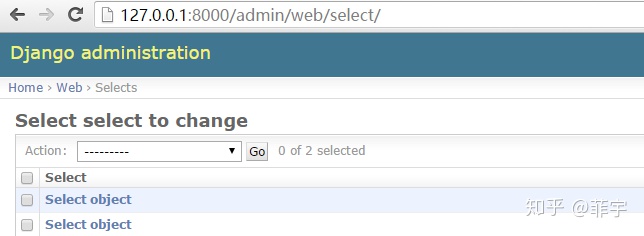

https://www.cnblogs.com/yangmv/p/5327427.html
http://www.liujiangblog.com/course/django/152




















 299
299











 被折叠的 条评论
为什么被折叠?
被折叠的 条评论
为什么被折叠?








